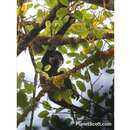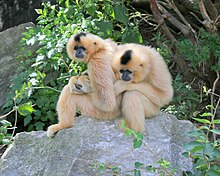en
names in breadcrumbs


Traditionally, all crested gibbons were considered members of a single species (Hylobates concolor), and this species was considered the only representative of the subgenus Nomascus in the genus Hylobates. Buff-cheeked gibbons were considered a subspecies (H. concolor gabriellae) of that species. Recently, vocal characteristics and other features have suggested that buff-cheeked gibbons should be recognized as a distinct species and the genus Hylobates was split into several genera, including Nomascus.
Gibbons are famous for their calls. Gibbon groups produce loud, stereotyped songs in the early morning. Songs are thought to function primarily in defense of resources such as territories, food trees, and mates. However, songs may also help to attract potential mates. Gibbon songs include species-specific characteristics which are inherited rather than learned.
Mated pairs of buff-cheeked gibbons typically produce duet songs which consist of coordinated vocal interactions by both partners using sex-specific phrases. Other family members may participate in the song. Solo songs are typically produced by unmated buff-cheeked crested gibbons only.
Also, buff-cheeked gibbons have extended fields of skin glands situated in the axillary, sternal, and inguinal areas of the body. The glands produce a reddish secretion and are particularly active under hot temperatures and when the animals are excited. It is thought that the glands may play a role in olfactory communication. The glandular secretion also influences the amount of red visible in the yellowish female pelage coloration.
Tactile communication occurs when these animals groom one another, play, or mate. Visual communication signals, such as body postures and facial expressions, are also used by these primates.
Communication Channels: visual ; tactile ; acoustic ; chemical
Other Communication Modes: duets
Perception Channels: visual ; tactile ; acoustic ; chemical
The species is threatened by habitat loss (from development and logging) and by hunting. Also, extensive military activities have had a detrimental effect on the species mainly through habitat destruction. This species is not efficiently protected at present, not even in nature reserves and national parks. There are some local laws forbidding the hunt of these animals, but they are poorly enforced. Only international trade laws that forbid sale of these creature and their body parts in Europe and the US are enforced.
US Federal List: no special status
CITES: appendix i
IUCN Red List of Threatened Species: endangered
There is no known threat or negative impacts to humans by N. gabriellae.
Some asian cultures use these animals for medicine, food, and pets, but not N. gabriellae exlusively. There is no particular eco-tourism draw with these animals.
Positive Impacts: pet trade ; food ; source of medicine or drug
Since all known behaviors and relationships are primarily studied in captivity, there is no documentation of the ecosystem role of N. gabriellae. However, the appetite of buff-cheeked gibbons for fleshy fruits would suggest they have a significant role in the disperal of seeds.
Ecosystem Impact: disperses seeds
This species is highly unstudied in the wild so all that is documented is from captive cases. Nomascus gabriellae is a selective eater and is mostly frugivorous. However, individuals have also been documented eating shoots, leaves, flowers, and occasionally insects.
Animal Foods: insects
Plant Foods: leaves; fruit; flowers
Primary Diet: herbivore (Frugivore )
Buff-cheeked gibbons are found in southeastern Asia, including southern Laos, eastern Cambodia, and central and southern Vietnam.
Biogeographic Regions: oriental (Native )
Gibbons are all primarily arboreal species that generally avoid walking on the ground or swimming. The genus name, Hylobates, actually means "dweller in the trees." Nomascus gabriellae is found in tropical evergreen forests. These primates prefer lowland forests, and are rarely seen between above elevations of 1,500 to 2,000 m.
Range elevation: 2,000 (high) m.
Habitat Regions: tropical ; terrestrial
Terrestrial Biomes: rainforest
Little research has been done on this species of gibbon in the wild, so its lifespan and survivorship in the wild are unknown. The only data on the lifespan of N. gabriellae is from captivity, where individuals of this species can live up to 50 years.
Range lifespan
Status: captivity: 50 (high) years.
Gibbons have small body size compared to the other great apes in the family Hominidae. They range in weight between 7 and 11 kg and reach lengths between 60 and 80 cm. They have extremely long arms and relatively long legs. The hands are so long that they appear hook-shaped. The thumbs on the hands are not elongated and are not used for swinging from branch to branch; instead these thumbs are used more for grooming behavior. The body is generally held in an upright position.
In N. gabriellae, males have small, light-buff cheek patches that extend to the bottom of the eye and can be slightly separated at the neck. Females of this species are smaller than other gibbon females and have a black border on the ears. Females are generally brownish-yellow in color and can have a slight grayish tint to the darker hairs on the chest, on edges of fingers and toes, and on the outer forearm. Adult females may have slightly red-brown genital hairs, and usually there is a trace of a white fringe around the face. The pelage of buff-cheeked gibbons is very fine. Finally, females are only slightly smaller than males.
Pelage coloration changes as animals mature. The timing of the color changes is variable and it may take several months to complete. When a buff-cheeked crested gibbon is born, its coat is bright yellow. Within a few months, the color changes to black within a few months; only the cheek patches remain yellow. During this time, the young resemble adult males in their fur coloration. Males retain this color pattern as they mature, but females revert to a yellowish pelage around the time of sexual maturity.
Range mass: 7.0 to 11 kg.
Average mass: 8.5 kg.
Range length: 60 to 80 cm.
Sexual Dimorphism: male larger; sexes colored or patterned differently
Other Physical Features: endothermic ; bilateral symmetry
Adult gibbons typically live in the crown region of the forest where they have no natural predators except humans. In the lower stories of the forest, leopards, clouded leopards, and pythons may be potential predators.
Known Predators:
The mating system of all gibbons is monogamy. All gibbon species have nuclear families consisting of a mated pair and 0 to 4 dependent offspring.
Mating System: monogamous
The breeding pair in the nuclear family can produce an infant every 2 to 3 years. The interbirth interval tends to be long because females nurse the young for up to two years. There has never been any record of twins being born in a buff-cheeked gibbon family. Buff-cheeked gibbons have a relatively long gestation of 7 months, and the offspring stay with the family unit for 6 to 8 years.
Breeding interval: These gibbons breed every 2 to 3 years.
Breeding season: Gibbons breed throughout the year.
Range number of offspring: 1 (low) .
Average number of offspring: 1.
Average gestation period: 7 months.
Average weaning age: 24 months.
Range time to independence: 6 to 8 years.
Range age at sexual or reproductive maturity (female): 6 to 8 years.
Range age at sexual or reproductive maturity (male): 6 to 8 years.
Key Reproductive Features: iteroparous ; year-round breeding ; gonochoric/gonochoristic/dioecious (sexes separate); sexual ; fertilization ; viviparous
Buff-cheeked gibbons have extensive parental investment by both parents. Females necessarily provide nutrition through nursing the young, but both parents may groom, carry, and protect the immature gibbons. The young stay with the parents for 6 to 8 years after birth. After this time, they move away to establish territories and families of their own.
Parental Investment: altricial ; pre-fertilization (Provisioning, Protecting: Female); pre-hatching/birth (Provisioning: Female, Protecting: Male, Female); pre-weaning/fledging (Provisioning: Female, Protecting: Male, Female); pre-independence (Protecting: Male, Female); extended period of juvenile learning
The yellow-cheeked gibbon (Nomascus gabriellae), also called the golden-cheeked gibbon, the yellow-cheeked crested gibbon, the golden-cheeked crested gibbon, the red-cheeked gibbon,[3] or the buffed-cheeked gibbon, is a species of gibbon native to Vietnam, Laos, and Cambodia.[3] The species was discovered and named after the British naturalist Gabrielle Maud Vassal.[4]
The yellow-cheeked gibbon is born blond and later turns black. Males carry this colouring through their lifespan and have the distinguishing golden cheeks. Females are born blonde to blend into their mother's fur but they later turn black. Females turn back to blond at sexual maturity, keeping only a black cap on the top of their heads.[5]
This diurnal and arboreal gibbon lives in primary tropical forest, foraging for fruits, using brachiation to move through the trees.

Little is known about this species in the wild, but it is thought that it has a life span of approximately 46 years.[6]
Gibbon groups vocalise loudly early in the morning. Their songs probably serve to defend resources such as territories, food trees, partners, but may also help to attract potential mates. Duetting occurs between mated pairs, the song is coordinated and contains sex-specific phrases.[7][6]
The largest known population of this species is found in Cambodia’s Keo Seima Wildlife Sanctuary, estimated at 1432 individuals in 2020. The population appears to be stable over the last decade.[8] There are several conservation programs active at the site, including protected area management supported by Wildlife Conservation Society[9] and a community ecotourism project centered on habituated gibbons.[10] A large protected wild population can be found in Cat Tien National Park: where a collaboration with the Endangered Asian Species Trust (UK), and Pingtung Wildlife Rescue Centre (Taiwan) founded the Dao Tien Endangered Primate Species Centre, which specialises on the rescue, rehabilitation and release of N. gabriellae and other endangered primates.
{{cite journal}}: Cite journal requires |journal= (help) The yellow-cheeked gibbon (Nomascus gabriellae), also called the golden-cheeked gibbon, the yellow-cheeked crested gibbon, the golden-cheeked crested gibbon, the red-cheeked gibbon, or the buffed-cheeked gibbon, is a species of gibbon native to Vietnam, Laos, and Cambodia. The species was discovered and named after the British naturalist Gabrielle Maud Vassal.
The yellow-cheeked gibbon is born blond and later turns black. Males carry this colouring through their lifespan and have the distinguishing golden cheeks. Females are born blonde to blend into their mother's fur but they later turn black. Females turn back to blond at sexual maturity, keeping only a black cap on the top of their heads.
This diurnal and arboreal gibbon lives in primary tropical forest, foraging for fruits, using brachiation to move through the trees.
 Female adults at the Cincinnati Zoo
Female adults at the Cincinnati Zoo Little is known about this species in the wild, but it is thought that it has a life span of approximately 46 years.
Gibbon groups vocalise loudly early in the morning. Their songs probably serve to defend resources such as territories, food trees, partners, but may also help to attract potential mates. Duetting occurs between mated pairs, the song is coordinated and contains sex-specific phrases.